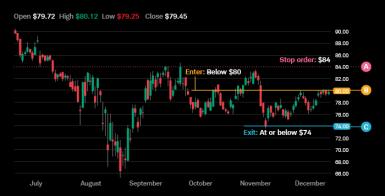The Ins and Outs of Short Selling

Many successful traders profit from stocks that rise in value. But some do the opposite—profiting from stocks that decline in value—through a strategy known as short selling.
Short selling involves borrowing a security and selling it on the open market. You then purchase it later at a lower price, pocketing the difference after repaying the initial loan.
For example, let's say a stock is trading at $50 a share. You borrow 100 shares and sell them for $5,000. The price suddenly declines to $25 a share, at which point you purchase 100 shares to replace those you borrowed, netting $2,500 in the bargain.
Short selling may sound straightforward, but this kind of speculative trading involves considerable risk. Here's a closer look at how it works—and what to consider before taking the plunge.
Getting started
Because you're borrowing shares from a brokerage firm, you must first establish a margin account to hold eligible bonds, cash, mutual funds, and/or stocks as collateral. As with other forms of borrowing, you'll be charged interest on the value of the outstanding shares until they're returned (though the interest may be tax-deductible).
Once you've opened and funded your margin account, you can start to research possible short-sale candidates. Traders typically use one or more of the following approaches to identify short-sale targets:
- Fundamental analysis: Analyzing a company's financials can help determine if its stock may be a candidate for a pullback. For example, a company's earnings per share (EPS) and sales growth tend to move in the same direction as its share price; hence, when looking for short-sale candidates, traders may consider companies with negative EPS and sales growth trajectories.
- Technical analysis: Patterns in a stock's price movement can also help you determine if it's on the cusp of a downtrend. One potential sign of a seller's market is a stock that's been falling through a series of lower lows while trading at higher volumes. Another is a stock that's rebounded to the upper range of its trading pattern but appears to be losing steam.
- Thematic: This approach involves betting against companies whose business models or technologies are deemed outdated (think Blockbuster Video), which can be more of a long game but can pay off should your prediction prove correct.
Entering a trade
As with any trade, you should identify your entry and exit points as well as a potential stop order before you begin (see “A simple plan” below). You'll want to enter a stop order to help limit your losses in the event the trade moves against you.
In general, two kinds of stop orders may prove useful:
- Buy-stop orders trigger an order to buy back the shares if the stock price rises to or above the stop price.
- Trailing buy-stops specify a stop price that follows, or “trails,” the lowest price of a stock by a percentage or dollar amount that you set. If the stock rises above its lowest price by the trail or more, it triggers a buy market order, at which point the stock is purchased at the best available price. If the price drops, the stop resets at a lower price.
However, neither of these methods guarantees that the order will execute at or near the price you designate, and in fact, the stop order could lock in losses if the price gaps up.
Understanding the risks
Short selling comes with numerous risks, but these are the big two:
1. Potentially limitless losses: When you place a standard trade, your downside is limited to 100% of the money you invested. But when you're shorting a stock, its price can keep rising, meaning that—theoretically—the amount you'd have to pay to replace the borrowed shares is limitless.
For example, you enter a short position on stock XYZ at $80, but instead of falling, it rises to $100. You'll have to spend $10,000 to pay back your borrowed shares—at a loss of $2,000. Stop orders can help mitigate this risk, but they're by no means bulletproof.
2. Margin calls: If the value of the collateral in your margin account drops below the minimum equity requirement—usually 30% to 35% of the value of the borrowed shares, depending on the firm and the particular securities you own—your brokerage may require you to deposit more cash or securities to cover the shortfall immediately.
For example, as long as your 100 shares of stock XYZ remain at $80 per share, you'll need $2,400 in your margin account—assuming a 30% equity requirement ($8,000 x .30). However, if the stock suddenly rises to $100 per share, you'll need $3,000 ($10,000 x .30)—requiring an immediate infusion of $600 to your account, which you may or may not have.
If you fail to meet the margin call, your brokerage firm may close out open positions to bring your account back to the minimum requirement.
Proceed with caution
At its most basic, short selling involves rooting against individual companies or the market, and some investors may be opposed to that on principle.
However, if you have a firm conviction that a stock price or index is heading lower, then shorting can be a profitable way to act on that instinct—so long as you're aware of the inherent risks.
What You Can Do Next
Ready to dive into the world of short selling? Watch Schwab's Trading Up-Close video on short selling strategies.
Join Schwab trading specialists live each market day for insights and answers to your questions.
Learn more about Schwab's trading tools.
 By
By
